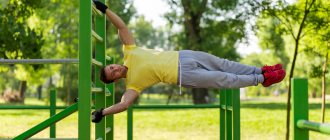May 31, 2021 Admin Home page » Tips and tricks
Are you pumping up your abs, but you can’t see them?! Find out the 6 main reasons and solutions to the problem to create a truly beautiful, sculpted belly.
You spend a long time in the gym, pay maximum attention to abdominal exercises, feel that it is there, but you can’t see it?! Most likely, you make mistakes like most people, not noticing simple solutions to the problem that lie right under your nose.
We present to your attention 6 reasons that hinder the creation of beautiful, sculpted abs; they will answer the painful questions of why the abs are not visible.
You perform isolation exercises on one muscle group
Everyone knows about the existence of the transverse abdominis muscle. Ignoring it during training may result in failure to obtain the desired result.
The transverse muscle is located in the abdominal area, but it is only activated when performing complex movements that simultaneously affect 2 muscle groups. For example, when rotating the pelvis, the transverse muscle receives the necessary impact, but we often ignore such an exercise.
Why are abs so important?
Beautifully formed abdominal muscles, since ancient times, reflected the health of warriors, the Spartans, Romans, Greeks, all had trained abs, even wearing special iron armor, they showed abs, not to mention their attractiveness to the female half of the population. Look at any lover or lover that women raved about, did any of them have weak abdominal muscles?
In modern life, much less attention is paid to this, but when you see a person with well-defined six-pack abs in men and a flat, sculpted stomach in girls, doesn’t an envious feeling of “toad” arise that they have it, but you don’t?! It arises, and how ;).
Look at the example of body fat content and find out your % body fat:
Being alone with their significant other, everyone at least once teased each other about the abs. In addition, well-developed abdominal and lower back muscles are the basis of the entire musculoskeletal system. An increase in the abdomen by 1 kg automatically increases the load on the lower back by 7 times.
Below we will describe the main reasons why the abs are hidden under a layer of fat, and you will be pleasantly surprised to get rid of them.
Have you ever tried high-intensity interval training?
Abdominal workouts are a great way to build muscle, but don't ignore full-body workouts.
Instead of running on the treadmill, try doing high-intensity interval cardio training. This type of exercise includes movements that help you burn calories quickly, so you can get chiseled abs faster.
Correct execution of exercises
To make your stomach flat in a minimum period of time, you should pay special attention to the exercise technique.
- Any workout should begin with a warm-up for 5-15 minutes.
- Fix your hands anywhere, but not behind your neck. This will prevent stress from being transferred to her muscles.
- It is good to fix your legs so that they do not move.
- When lifting your body up, exhale, while going down, inhale.
- There should be enough repetitions, the muscles should hurt a little, but not languish from tears. With each session you can increase the load.
- The workout ends with stretching. This prevents muscle clogging and reduces pain levels after intense pumping.
Pumping up your abs at home is a real task. However, you should approach the problem comprehensively and avoid making common mistakes.
Exercises to train your lower abs
Exercise No. 1.Starting position - lying on your back, legs straight, hands on the back of your head, elbows spread to the sides. Tightening your abdominal muscles, slowly raise your legs while bending your knees. Try to press your knees as close to your chest as possible. After freezing in this position for a few seconds, smoothly return your legs to their original position. If your physical fitness allows, you can make the exercise more difficult by performing it without bending your knees. At the same time, try to raise your straight legs as high as possible. |
Exercise No. 2.Starting position - lying on your back, arms extended along the body with palms down or placed under the buttocks, legs bent at the knees and slightly raised above the floor. Pull your legs towards your chest, leaving your shoulders and lumbar region motionless. Do not lower your feet to the floor until the end of the exercises. |
Exercise No. 3.Starting position - lying on your back, arms extended along the body and placed under the buttocks, legs bent at the knees and pressed one against the other, shoulders and lumbar region fixed in place, neck muscles relaxed. Without lifting your shoulder blades from the floor, gently lower your legs to the side, alternating between the right and left sides. If the exercise is easy enough, make it more difficult by holding a small ball between your knees. |
Exercise No. 4.Starting position - lying on your back, hands on the back of your head, elbows apart, legs bent at the knees. Alternately pulling your legs towards your chest, imitate the movements of a cyclist, without touching the floor until the end of the exercise. |
Exercise No. 5.Starting position - lying on an inclined bench, head at the top, hands holding the bench above your head, legs straight, neck muscles relaxed. Without bending your knees, raise your straight legs as high as possible. Try to perform the exercise slowly and smoothly, tensing your abdominal muscles as much as possible. |
LiveInternetLiveInternet
Pumped up abs are the dream of not only many men, but also some women. They go with this dream to the gym, to a fitness center, or work out on their own at home. They train until they sweat, they give it their all, but there is no result. Instead of sculpted abs decorating the torso, there are aching muscles, aching joints and headaches. Fitness trainers named the most common mistakes when pumping the press.
Incorrect execution
It often happens that as a result of improper training, even more problems appear than before. If you do exercises for your abs and abdominal muscles and experience pain or fatigue in your back, this is a signal to you that something is going wrong. In the video we will look at the popular abdominal exercise “twisting” and one of the most common mistakes when performing this exercise, which instead of abs will lead you to a herniated disc, titanium hip joints, scoliosis...
The abdominal muscles bend the torso. More precisely, with a fixed spine and pelvic girdle, the rectus abdominis muscle lowers the ribs, pulls the chest down, and bends the spine. Hence the conclusion - when performing the exercise, you should be focused on exactly these things: maximum flexion of the spine in the thoracic region, which, in fact, sets the trajectory, the downward movement of the chest, i.e. to the pelvis when performing crunches.
Important! Avoid lifting your lower back from the surface you are lying on. Maximum contraction of the abdominal muscles occurs when the upper back is rounded. Focus on moving your ribs towards your navel. Lift your chest literally a few centimeters - this is enough to tense your stomach. Imagine holding an apple between your chin and chest throughout the curl. This will ensure the correct position of the neck. You can also cross your arms over your chest or place your fingers around your ears with your elbows pointing forward.
Crunches are not sit-ups. When you go too high, you transfer the load from the rectus abdominis to the hip flexors.
When performing twists, there is no need to strive upward; the movement should be directed forward and towards maximum flexion of the spine. The straighter your spine is when performing this exercise, the less stress on the rectus abdominis muscle.
Make sure your movements are smooth. At the end of each twist, rest your back on the floor. Slow down before doing the next rep.
Overzealousness
This is a beginner's mistake. They so want to get pumped up abs quickly that they are ready to train for several hours in a row, looking at the abdominal area every 5-10 minutes to see if the coveted abs have already appeared? This approach has two ways of developing events. First: severe overexertion as a result of long workouts, nausea and even vomiting during or after exercise, which appears due to excessive stress on the digestive system, poor health in general.
Second: having given his all and wasted his ardor in 2-3 workouts and suffering from muscle and joint pain, the beginner loses interest in training, comes up with reasons for skipping them, justifies his reluctance to continue doing urgent things and, in the end, gives up the idea of pumping up his abs.
For high-quality muscle growth, a gradual increase in load . From one workout to another. If you increase it too often and sharply, then very soon you will notice that the muscles do not increase at all, but the energy rapidly decreases, lethargy, apathy, depression sets in - all signs of classic overtraining.
Improper breathing
This is one of the most common mistakes. People, while pumping up their abs, do not pay attention to how they breathe, meanwhile, only with proper breathing can you achieve a positive result in a short time and practically without experiencing pain in the joints and muscles after training. Most often what happens is this: a person holds his breath for 4-5 ascents, after which he greedily gasps for air, takes a deep breath and again does not breathe during several ascents.
But muscles need oxygen, especially during training. Without it they cannot work fully. Yes, muscles are a real factory for processing fat and burning calories, but it needs raw materials. In this case, oxygen plays its role. And if raw materials arrive intermittently, the entire work process stops. All movements have zero effect. Or even with a minus sign. How to breathe: at the moment of relaxation - inhale, and at the moment of maximum tension - exhale.
This breathing rhythm will seem difficult at first. You will have to strictly control yourself. After 2-3 workouts, proper breathing will become the norm.
Exercise immediately after eating
This mistake is often made by those who, in addition to pumped up abs, also want to remove a few centimeters from the waist. People think that the calories received by the body during a heavy lunch eaten immediately before exercise will somehow miraculously disappear during training, which means they will not be deposited as a layer of fat. This is wrong. Training with a full stomach will lead to nausea, profuse sweating, arrhythmia, and headache. With intense movements, intestinal volvulus is also possible.
However, it is also harmful to exercise on an empty stomach. The optimal solution is to eat a meal rich in natural carbohydrates half an hour to an hour before training.
Monotonous press swing
The most famous abdominal exercise is lying on your back, hands clasped at the back of your head, knees bent, head pulled up. Unfortunately, this exercise only trains the upper (front) abdominal muscles. While the oblique and lower muscles remain unused. You can’t pump your abs monotonously, training some and ignoring other muscle groups . Exercises should be different. The coach will tell you which ones exactly.
If we are talking about independent training, you can download video lessons of abdominal exercises from professional trainers from the Internet and conduct classes in accordance with their recommendations.
Leg fixation
Almost always, when doing abdominal exercises, people fix their legs in a stationary position (under a bench, in special loops, ask someone to hold them). This is believed to promote greater concentration on the abdominal area. This is a misconception. If the legs are fixed, the thighs begin to work powerfully, not the abdominal muscles. To avoid this mistake, it is better to perform swinging movements on an inclined bench without fixing your legs . In this case, the abdominal area will actively work. If you take into account the mistakes discussed above and adhere to the basic rules when working on your abs, then you will be able to avoid excessive loads, pain and injuries, and most importantly, you will be able to effectively work on this muscle group, which will allow the time spent on training not to be wasted.
A few rules
Do you want to have a flat stomach? Then you must adhere to the following rules when training your abs:
✔No need to pump up your abs to burn belly fat. Getting rid of fat is, first of all, maintaining proper nutrition. Cubes are the result, first of all, of a diet aimed at burning fat. And only in the second - abdominal exercises. Sorry, but local fat loss only happens in commercials, don’t take it as wishful thinking. You won't burn more waist fat by doing more reps of abdominal exercises periodically! Unfortunately for many exercisers, they have to go on a strict diet and/or do cardio work to burn fat throughout their body. But don't 100 sit-ups count as cardio? No. These 100 repetitions will burn fewer calories than a small apple. The best strategy is to gradually reduce calories (100-200 calories per day every three weeks) and/or increase the aerobic component of your workouts. This way you will gradually remove fat from your waist. When your body fat percentage drops below 10%, you will see your abs. If you want the cubes to stay in place even when you're relaxed, you need to increase this figure to six percent. For most exercisers, this means reducing calories in even smaller increments every 2-3 weeks until the daily caloric intake drops to 2,000 calories. If your body fat percentage is still unsatisfactory, you should increase your aerobic activity and/or use fat-burning supplements, which can speed up your metabolism and sweep away the last remaining fat from you. The lower your body fat content becomes, the more difficult it is to continue losing weight. But don't give up. With some persistence, the right training program and methodically reducing caloric intake, you will get sculpted abs and will be rewarded with admiring glances from others.
✔There is no need to do several exercises separately for the “lower” and “upper” abs. Anatomically, the rectus abdominis muscle is not divided into upper and lower, but is ONE muscle. A couple of abdominal exercises and changing them periodically are enough.
✔Don’t make it easier for yourself with jerks. The exercises are performed quite smoothly; the downward movement (of the legs or torso) should also be controlled.
✔If you want muscle growth, follow the same principles as when training other groups, namely, you need to increase the load (weights), you need time for recovery, you need an adequate number of repetitions in the approach and exercises for this group. You don't have to do 5 heavy abdominal sets every workout.
✔Remember that exercises for the lateral abdominal muscles (any exercise in which the torso bends to the side and rises from this position) lead to an increase in these muscles (and not to fat burning in the waist area) and, accordingly, to some widening of the waist. Is this what you really wanted when you started doing dumbbell curls? Based on materials from fashionstylist.kupivip.ru
See also:
Abdominal training: trainer's advice
How to do abdominal exercises correctly
We pump up the press according to all the rules
No need to raise straight legs and a straight body
Maximum contraction of the abdominal muscles occurs when the back is rounded and the chin is pressed to the chest. In all variations of twisting, you need to imagine that you are curling up in a ball.
In all variations of leg lifts, you need to slightly bend your knees and try to lift not your legs, but your pelvis. This will reduce the load on the hip flexors and quadriceps, and load the abdominal muscles to the maximum.
In addition, there is a study about the risk of injury in the lumbar region of some abdominal exercises. We talked about this in detail in the text “How to pump up the press correctly.”
Daily abdominal workouts - success or waste of time
To have sculpted abs, you need to pump them up every day. Where did this myth actually come from?
In the distant 50-60s of the twentieth century, physiologists argued that the abdominal muscles are very durable. Therefore, the press can easily recover from a power load within a day.
All star bodybuilders in those days pumped up their abs every day. Moreover, they pumped up their abs not by quantity, but by time! Set the alarm clock for 20-30 minutes and continue doing crunches without stopping. Until the alarm clock rings.
In the 70s, professional bodybuilders continued to pump up their abs every day. But they already did, some “funny” ones, 1000 repetitions per day. Three hundred repetitions in the morning, three hundred in the afternoon, and four hundred in the evening.
This is exactly how Frank Zane pumped up his legendary abs, the standard of relief of the 70s.
In the 80-90s, bodybuilders began to pump their abs 2-3 times a week. Doing 20-30 repetitions in one approach.
And apotheosis! Many modern professional bodybuilders do not lift their abs for months! They begin to actively do abdominal exercises 1-2 months before the competition!
Consistently look at photos of bodybuilders from the 60s to our time. You will notice a clear trend. With every decade, the quality of the press gets better and better. The percentage of belly fat is getting smaller and smaller. At the same time, bodybuilders pumped their abs less and less!
In modern bodybuilding it has already been clearly established:
Sculpted abs are 70% dependent on proper diet.
Remember! No amount of daily abdominal training will help you if you have severe eating disorders.
Don't look for easy ways
Your goal is to increase the load on your abdominal muscles, not decrease it. Here are a few ways to make any exercise more challenging:
- Maintain the peak contraction for some time rather than immediately going into the negative phase of the repetition.
- Do your reps slower; use smooth and controlled movements to reduce the impact of momentum.
- When performing abdominal exercises on the floor, do not allow your shoulder blades to touch the surface between repetitions. This touch instantly relieves tension from the muscles.
So then, you can’t pump up your abs on mass?
Individual question. Now I will explain...
In any case, if you pump, it’s not to see the enviable abs on your stomach)). I hope it's clear why? =) If you pump it, it’s to strengthen the rectus abdominis muscle (i.e., the abs), because a strong abs (rectus abdominis muscle) = prevents injuries to the back muscles.
For those who don’t know, the abs are a stabilizer of the torso. Accordingly, when performing various exercises in bodybuilding and other sports (well, for example, squats, deadlifts, presses, etc.), a strong press prevents your back from falling apart or being injured. Do you understand?
Therefore, if you pump (train) your abs, then only for this reason. By the way, this is especially true for beginner athletes and athletes who have not yet developed anything. What I mean is that this category of people, before starting to master basic exercises such as squats, deadlifts, presses, etc. It would be important to strengthen the rectus abdominis muscle (abs) and the extensors of the back muscles (lower back).
For advanced athletes performing basic multi-joint exercises such as squats, presses, deadlifts, etc. the press already receives a strong dose of stress (on its own). Do you understand? For this reason, many athletes do not train their abs at all, because... concentrate on many basic movements that develop other areas of the body, but in which the abs are actively involved.
Many people wonder how it is involved in those exercises? =)
The answer is obvious - the abdominal muscles in these exercises work as stabilizer muscles.
But, be that as it may, each athlete decides for himself whether to pump or not to pump. Personally, I (since I do all the basic exercises in which the abs already receive sufficient load), I do this very rarely (optional), most often with 1 exercise, well, maximum 2 at the end of the workout or at the beginning, as a Again, I watch the warm-ups on my own. I’ve never done a separate abdominal workout, I hope after reading this you understand why. Ps I’m not imposing anything on anyone, see for yourself.
Some tips for training your abs
It's important to not only train your core, but to do it correctly to avoid injury. Below I will give you general tips and tricks that will help you achieve results.
- Perform exercises without jerking or sudden movements. Sometimes, for example, when lifting your legs while hanging, there is a great temptation to make a movement by inertia. Try to avoid this, as this will prevent you from fully engaging your abdominal muscles. Do not help yourself with your hands when doing crunches. Many people sin with this and strive to pull their heads in the right direction.
- Don't forget about breathing. How to breathe when doing abs? Exhale while contracting (tensioning) the muscles, and inhale while relaxing. Firstly, proper breathing will allow you not to get tired longer, and secondly, proper breathing is the key to athletic longevity and cardiovascular health
- Many exercisers are interested in: is it possible to pump up the abs after eating? The answer is no. After eating, you need to wait 1-2 hours, unless you want to see your entire pre-workout meal on the floor
- This advice applies exclusively to girls. It is not recommended to exercise your stomach during your cycle, especially if it hurts! Please be patient for a couple of weeks, otherwise the bleeding may get worse.
- Sometimes you can use abdominal exercises to warm up. It is not recommended to do this if you have planned strength training with squats or back exercises (deadlifts, bent-over rows of barbells or dumbbells), since the abdominal muscles take an active part in these movements as stabilizers
- The abs must be trained until you feel an unbearable burning sensation. This is the only way you will achieve results. The abdominal muscles, by their nature, consist mainly of intermediate muscle fibers, so when training you need to use an integrated approach. This means that the abs equally need to be trained both in a high-repetition mode, 20 or more repetitions without additional weights, and with additional weight and a small (from 8 to 15) number of repetitions
If you have weak abs, pump them up at the beginning of your workout.
At the beginning of your workout you will be full of energy and strength, but make it to the end and there is a high chance that you will leave the gym having given up on abdominal exercises. Another principle that works is abdominal training between sets for a large muscle group. Maybe not after the heaviest set of squats, but later in the same session this technique will work, because exercises for the abdominal muscles are not so demanding on the respiratory or nervous system.
Reverse crunches on an incline bench
I myself work out the abdominal muscles last, since they are already in perfect order, all thanks to many years of training. Honestly, if I skip an ab workout, it won't make any difference to my life.
Compliance with safety precautions during exercises
Safety requirements for abdominal training are generally the same as in other cases:
- make training movements smoothly, under control, without jerking,
- pre-warm up your muscles by warming up (at least 5-8 minutes),
- under load, do not round your back (except for twisting),
- during twisting, the lower back should not come off the floor,
- all efforts are performed while exhaling, returning to the starting position while inhaling,
- If during exercise you feel discomfort in the back area, or even more acute pain, stop training immediately and consult a doctor,
- You should not do the workout immediately after a meal; at least 1 hour should pass from the meal to the workout, and if the meal was large, then 2 hours.
As in all other cases, before a new workout, the muscles must be allowed to rest and recover, but at the same time, we talked about the fact that the abs recover very quickly. Therefore, the question of how often to train the abs is very relevant for many. Here we can recommend paying attention to your own feelings. Muscle pain caused by training should be completely gone before you train again.
It is often recommended to train the abs every other day, for example on Monday, then Wednesday and Friday. If during this time your muscles stop hurting and there is no discomfort when they contract, you can safely go to a new workout. If not, wait another 1 or 2 days. There's no need to rush here. If the muscles have not recovered, with a new workout you will overload them even more and, as a result, the muscles will degrade instead of growing.











